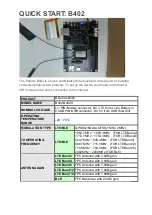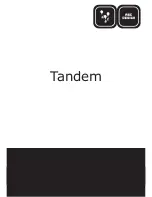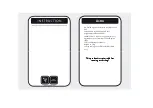
3-
5
3
I/O INTERF
ACE
3-2 Input Signal Description
■
Return-to-origin command (ORG-S)
This command returns the robot to its origin position by using stroke-end detection as the origin
detection method.
n
NOTE
The magnetic pole is detected simultaneously with return-to-origin operation. Return-to-origin is incomplete each
time the power is turned on. Always perform return-to-origin after turning on power to the controller, before
starting operation. Return-to-origin is also always incomplete after a parameter related to the origin position is
changed. Return-to-origin must be re-performed in this case.
c
CAUTION
If the robot is operated while return-to-origin is still incomplete, the necessary thrust to move the robot is
unavailable and an alarm or abnormal operation occurs. Always perform return-to-origin before starting robot
operation.
c
CAUTION
When performing return-to-origin by the stroke-end detection method, do not interrupt return-to-origin
operation while the origin position is being detected (robot is making contact with its mechanical limit).
Otherwise, the operation will stop due to a controller overload alarm and the power will need to be turned off
and back on again.
c
CAUTION
Do not continuously repeat return-to-origin operation. If return-to-origin must be repeated by the stroke-end
detection method, wait at least 5 seconds before repeating it.
■
Servo recovery command (SERVO)
After emergency stop, releasing the emergency stop button and turning this input on (closing
the contact) turns the servo power on, so the robot is ready for restart.
(As with other dedicated command inputs, the servo recovery command should be a pulse
input, so it must be turned off (contact open) when the BUSY signal turns on.)
n
NOTE
When the servo is first turned on after power-on, a sound is heard for 0.5 to 2 seconds during servo-on. This sound
is produced by a small robot movement for acquiring information needed to control the robot, and is not an
abnormal condition.
■
Reset command (RESET)
This command returns the program step to the first step of the lead program and turns off the
general-purpose outputs and the memory I/O. It also clears the point variable "P" to 0.
* When PRM33 ("Operation at return-to-origin complete" parameter) is set to 1 or 3, DO4 does
not turn off even if the reset command is executed. Likewise, when PRM46 ("Servo status
output" parameter) is set to 1, DO3 does not turn off even if the reset command is executed.
n
NOTE
The lead program is the program that has been selected as the execution program by the TPB or POPCOM. (See
"9-4 Switching the Execution Program".)
The lead program can also be selected by executing a communication command "@SWI". It may also be selected
when the program data is loaded into the SRCP30 controller from the memory card.
Содержание SRCP30
Страница 1: ...User s Manual ENGLISH E E104 Ver 1 02 SRCP30 YAMAHA SINGLE AXIS ROBOT CONTROLLER MF100 ...
Страница 2: ......
Страница 8: ...vi MEMO ...
Страница 26: ...2 10 MEMO ...
Страница 130: ...8 34 MEMO ...
Страница 144: ...9 14 MEMO ...
Страница 174: ...10 30 MEMO ...
Страница 216: ...12 10 MEMO ...
Страница 232: ...14 4 MEMO ...
Страница 233: ...15 1 15 SPECIFICATIONS Chapter 15 SPECIFICATIONS ...
Страница 238: ...MEMO 15 6 ...
Страница 239: ...16 1 16 APPENDIX Chapter 16 APPENDIX ...
















































